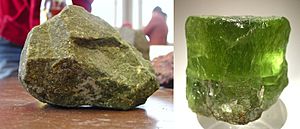Peridotite facts for kids
| Igneous rock | |

Typical peridotite sample (dunite, left) and large olivine crystal (right)
|
|
| Composition | |
|---|---|
| olivine, pyroxene |
A peridotite is a type of igneous rock. This means it formed when hot, melted rock cooled down. Peridotite is mostly made of two important minerals: olivine and pyroxene. It gets its name from the beautiful green gemstone called peridot.
Peridotite is very important because it makes up most of the upper part of the Earth's mantle. The Earth's mantle is a thick layer of rock found deep inside our planet, below the crust where we live.
Contents
What is Peridotite?
The word peridotite comes from the gemstone peridot. Peridot is a pale green color and is actually a type of olivine. A classic peridotite rock is usually bright green with small black spots. However, many samples you might see are a darker green.
Colors of Peridotite
When you find peridotite rocks in nature, they can look different. They might be an earthy bright yellow or a dark green. This happens because the olivine in the rock can easily change when it's exposed to air and water. This process is called weathering, and it turns the olivine into a material called iddingsite. Even though green and yellow are common, peridotite can also be blue, brown, or red!
Where is Peridotite Found?
Peridotite is mostly found deep inside the Earth, in the Earth's mantle. It's the main rock that makes up this huge layer.
How Peridotite Reaches the Surface
Sometimes, peridotite can be brought closer to the Earth's surface. This can happen in a few ways:
- Volcanoes: Small pieces of the mantle, called xenoliths, can be carried up by volcanoes during eruptions.
- Mountain Building: During the formation of large mountain ranges, huge blocks of rock can be pushed up from deep within the Earth.
- Ocean Floors: Peridotite can also be found where the Earth's plates pull apart under the ocean.
More Pictures
-
Here you can see olivine in a peridotite rock changing into iddingsite due to weathering. This piece of rock came from the Earth's mantle.
See also
 In Spanish: Peridotita para niños
In Spanish: Peridotita para niños





